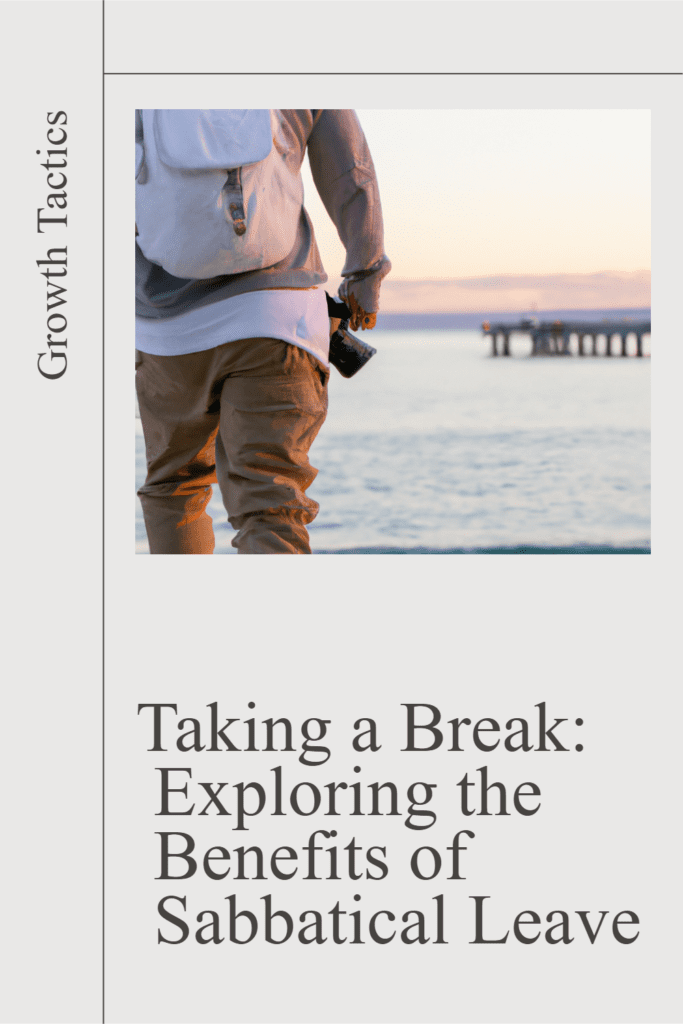Are you feeling overwhelmed and in need of a break from the daily grind? If so, you’re in the right place. In this blog post, we’ll be diving into the topic of sabbaticals and why they’re worth considering. We’ll explore everything from sabbatical leave policies to the different types of sabbaticals and their benefits. So, let’s get started!
What is a Sabbatical?
Sabbatical, it’s a word that might bring to mind images of academics taking a year off from teaching to focus on research. But did you know that sabbaticals can be beneficial in various fields and industries, including human resources (HR)? In simpler terms, a sabbatical is an extended period of leave from work that employees can take for personal or professional development, rest, or any other purpose.
Exploring Sabbatical Leave Policies
Companies nowadays understand the importance of work-life balance and the need for employees to recharge from time to time. That’s why many organizations have developed sabbatical leave policies. These policies outline the rules and guidelines that govern sabbatical leaves and clarify whether they are paid or unpaid.
As an employer, it’s crucial to offer sabbatical leave to employees as a form of support and recognition. This creates a positive work culture and demonstrates a commitment to employee well-being. Sabbatical leave can be implemented in various ways, including offering paid or unpaid sabbaticals, defining the length of the sabbatical period, and setting eligibility criteria.
The Different Types of Sabbaticals
Taking a break from work can be an incredible opportunity for personal growth, and there are various ways you can structure your sabbatical to make the most of it. So, let’s explore the different types of sabbaticals!
1. Travel Sabbatical
Imagine packing your bags, hopping on a plane, and embarking on an adventure around the world. A travel sabbatical allows you to explore new cultures, try exotic foods, and create memories that will last a lifetime. From trekking in the Himalayas to sipping coffee in Parisian cafes, the world becomes your classroom during a travel sabbatical.
2. Study Sabbatical
If you’re a perpetual learner and love expanding your knowledge, a study sabbatical might be right up your alley. This type of sabbatical allows you to dive deep into a subject you’ve always been fascinated by. You could enroll in a language course, attend workshops on a particular skill, or even pursue advanced degrees. With a study sabbatical, you have the chance to sharpen your mind and gain new expertise.
3. Volunteer Sabbatical
What if you could use your skills and time to make a positive impact on the world? A volunteer sabbatical allows you to do just that. Whether it’s teaching English in remote villages, building homes for those in need, or working with environmental organizations, a volunteer sabbatical gives you the opportunity to contribute to meaningful causes and give back to communities.
4. Entrepreneurial Sabbatical
Have you been nurturing a business idea but never had the time to bring it to life? An entrepreneurial sabbatical might be the perfect chance to give your dream venture a shot. Whether it’s starting a small business, writing a book, or launching a passion project, this type of sabbatical allows you to focus on your entrepreneurial pursuits and turn your ideas into reality.
5. Family Sabbatical
For those with family obligations and a desire for quality time, a family sabbatical can be an incredible opportunity. Whether you want to spend more time with your kids, reconnect with loved ones, or create unforgettable memories, a family sabbatical allows you to prioritize your loved ones and strengthen those important bonds.
Finding the Right Fit
Remember, there’s no one-size-fits-all approach to sabbaticals. The type of sabbatical you choose should align with your goals, interests, and personal circumstances. It’s essential to take the time to reflect on what you hope to achieve during your sabbatical and choose a path that brings you joy and fulfillment.
So, whether you’re yearning to explore new places, learn new skills, make a difference, or spend time with loved ones, there’s a type of sabbatical out there that’s perfect for you. Embrace the opportunity, plan thoughtfully, and get ready for a transformative experience.
Paid or Unpaid: Exploring the Options for Sabbatical Leave
When it comes to taking a sabbatical, one of the important considerations is whether it will be paid or unpaid. Each option has its own benefits and implications, so let’s dive into the details and explore both scenarios.
The Benefits of a Paid Sabbatical
Paid sabbaticals are an attractive option for many employees. Not only do they provide the opportunity to take time away from work, but they also ensure that your finances remain stable during your break. With a paid sabbatical, you can fully focus on rejuvenating yourself, pursuing personal interests, or developing new skills without the added stress of financial strain.
From an employer’s perspective, offering paid sabbaticals can be seen as an investment in employee well-being and job satisfaction. When employees know they won’t be losing income while taking a sabbatical, they’re more likely to return to work refreshed and motivated. This can lead to increased productivity, creativity, and loyalty in the long run.
The Freedom of an Unpaid Sabbatical
On the other hand, an unpaid sabbatical can also be an appealing option for those who prioritize personal growth or have financial flexibility. Taking an unpaid sabbatical allows you the freedom to tailor your break without the constraints of work obligations. It provides an opportunity to fully immerse yourself in new experiences, explore new paths, or even travel the world.
While unpaid sabbaticals may require careful financial planning, they can offer a valuable chance to pursue passions or take a well-deserved break. It’s important to consider your personal circumstances and weigh the benefits against any potential financial challenges. Saving up for an unpaid sabbatical can be a worthwhile endeavor if it aligns with your goals and aspirations.
Finding the Right Balance
Ultimately, the decision between a paid or unpaid sabbatical will depend on a variety of factors, including your financial situation, career goals, and personal circumstances. It’s crucial to have open and transparent communication with your employer about your intentions and explore any available policies or options. Some organizations may have specific guidelines or even sabbatical programs in place to support their employees.
Remember, taking a sabbatical is not just about the immediate benefits but also the long-term impact it can have on your well-being and professional growth. Whether paid or unpaid, a well-planned sabbatical can provide you with the much-needed rest and rejuvenation to return to work with renewed energy and perspective.
How Long is Sabbatical Leave?
Embarking on a sabbatical journey is an exciting prospect, and one question that often comes to mind is, “How long can a sabbatical leave actually be?” Well, my curious friend, the length of a sabbatical leave can vary depending on several factors.
Duration: A Flexible Framework
Sabbatical leaves typically range from a few weeks to several months, and in some cases, even a year or longer. The specific duration is often determined by the organization’s policies, the employee’s needs, and the purpose of the sabbatical. For instance, a shorter sabbatical could be a refreshing break to recharge and rejuvenate, while a longer one offers the opportunity for deep exploration and personal growth. Ultimately, it’s about finding the right balance that aligns with both the individual’s goals and the organization’s needs.
Tailoring to Individual Circumstances
Individual circumstances also play a role in determining the length of a sabbatical leave. Factors such as job responsibilities, financial considerations, and personal commitments can influence the duration. While some companies may have set policies outlining specific timeframes for sabbaticals, others may have more flexible arrangements that allow employees to negotiate the length based on their unique circumstances. The important thing is to have open communication with your employer to discuss your goals and work together to find a duration that works for everyone involved.
Remember, the purpose of a sabbatical is to provide a break from work, to immerse oneself in personal growth or explore other interests. So, whether it’s a few months to learn a new skill, six months to travel the world, or a year to pursue a passion project, the length of your sabbatical leave ultimately depends on what you hope to achieve and how it fits into your life’s puzzle.
Implementing a Sabbatical Program
If you’re an employer considering implementing a sabbatical program, it’s essential to first define your organization’s sabbatical leave policy. This policy will establish the eligibility criteria, the length of the sabbatical period, and whether it’s paid or unpaid. It’s also important to communicate the policy clearly to employees so they understand the requirements and benefits.
Sabbaticals can bring numerous benefits to both employees and employers. Employees gain the opportunity to recharge, explore new interests, and return to work rejuvenated and motivated. Employers benefit from increased employee engagement, retention, and positive workplace culture.
So, if you find yourself in need of a break, consider discussing the possibility of a sabbatical with your employer. It could be just the thing you need to nourish your mind, body, and soul.
Hey there, curious friend! If you’re interested in implementing a sabbatical leave policy in your organization, you’re in the right place. In this section, we’ll discuss how to create a sabbatical leave policy template that outlines the rules and guidelines of taking a sabbatical leave.
Putting Together a Sabbatical Leave Policy
When creating a sabbatical leave policy, you’ll want to keep in mind the purpose of the policy and the goals of your organization. A well-crafted policy can benefit both employees and employers, setting clear expectations and creating a positive workplace culture. Here are some key elements to consider when putting together a template:
Eligibility Criteria
The first step in creating a sabbatical leave policy template is to define eligibility criteria. Who is eligible to take a sabbatical? Will employees need to work for a certain length of time or meet certain performance standards? Clearly setting eligibility criteria can help employees understand their options and ensure that your sabbatical policy remains fair and consistent.
Length of the Sabbatical
Another important element to consider is the length of the sabbatical. How long can employees take off from work, and will the length of the break be the same for everyone? It’s essential to establish clear guidelines around the length of the sabbatical to avoid confusion or miscommunication.
Paid or Unpaid
As we’ve explored earlier in this article, one of the significant considerations for sabbatical leave policies is whether they will be paid or unpaid. Clearly defining the terms of the sabbatical pay can motivate employees and show your commitment to employee well-being.
Returning to Work
The sabbatical leave policy template should also outline the conditions for returning to work. Will employees need to submit a report about their sabbatical experience? Should employees have the same job responsibilities when they return, or will there be any changes to their role? Addressing these questions in the policy can make the transition back to work smoother for everyone.
Communicating the Policy
Once you’ve created a sabbatical leave policy template, you’ll want to communicate it effectively to your team. Consider hosting a team meeting or sending out an email outlining the new policy and how to apply for sabbatical leave. Ensure that everyone understands the details and benefits of the policy, and encourage employees to take advantage of the opportunity for personal and professional growth.
Key Points to Remember
- Sabbaticals are an extended period of leave from work that employees can take for personal or professional reasons.
- Many organizations have sabbatical leave policies that outline the rules and guidelines for taking a sabbatical.
- Sabbaticals can be paid or unpaid, and there are various types, including personal development, professional development, and extended breaks.
- Implementing a sabbatical program can benefit both employees and employers, fostering employee well-being and engagement.


